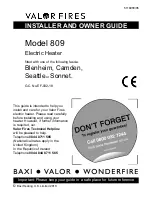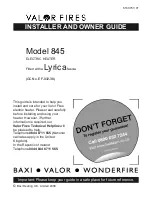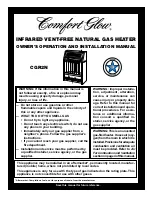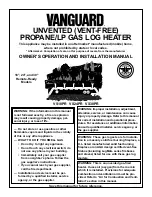
Riverina SRS3 Insert
4
Riverina SRS3 Insert
9
Installation
Operating your Jindara
(Continued)
40
690
660
810
836
550
763
20
Zero
Clearance
Box
20
12mm Cement Sheet Min.
Triple skin
Flue
Vent
Vent
Villaboard can overlap clearance gap
between ZCB and frameing, and run
over the front of the ZCB. Do not silicon or
adhear villaboard to ZCB as heat expantion
of ZCB will cause cracking.
A min.
140mm gap
between flue outer
casing and timber
stud
Figure 2. ZCB Installation detail
Clearance to combustibles & Gason Zero Clearance Box (ZCB) installation
The Jindara Riverina
Insert conforms to AS/NZS 2198:2001 Appendix B, when the appliance is placed in relation to
combustible surfaces, as per test report number HCMG/13/030.
The Gason Zero Clearance Box is an approved cabinet that allows certain Jindara & Eureka Insert woodheaters, in
conjunction with a triple skin flue system to be installed within a non-masonry fireplace in accordance with
AS/NZS 2918:2001.
WARNING
!
DO NOT ATTEMPT TO OPERATE THIS APPLIANCE WITHOUT READING AND
UNDERSTANDING THESE OPERATING INSTRUCTIONS THOROUGHLY. FAILURE TO
OPERATE THIS APPLIANCE PROPERLY MAY CAUSE UNDUE DAMAGE TO THE
APPLIANCE OR RESULT IN A FLUE FIRE.
Read these instructions
Starting your fire
Place a firelighter or paper in the bottom of the firebox and place a large amount of small kindling on top. Ignite the
paper or the firelighter. Set the air control to high and leave the main door open approximately 25mm. When the kindling
is burning, place about four pieces of small wood on top of the burning kindling. Once the wood is alight, close the main
door. After approximately 20 minutes, turn the air control down to medium and, turn the fan on to low speed.
On the initial fire up you may detect smoke coming from the paint finish and from any oils that may be on the steel on
the outside of the firebox. This is normal. It is suggested to well ventilate your home on the initial fire up. Please refer to
our section ‘Paint curing and cure’.
The glass door
Always operate your heater with the door closed and locked. The only time you can leave the door open is on initial
lighting, or when reloading the heater.
Care of your glass
If you are burning good dry wood, you will have very little discolouration of your glass in normal burning cycle. If you aim
for an eight to ten hour overnight burn, you should not get much discolouration. You can control this by adjusting the air
control, moving from the left and slowly creeping the control to the right. After a number of days you will find the right
position to suit your requirements and the fuel that you are using.
Cleaning the glass
Generally the only time you will possibly need to clean your glass is after a long overnight burn. If you find that you have
a wet sticky black film on your glass (creosote), it is better to burn the heater as normal for one load of wood. When the
wood has burnt down to a hot bed of embers, open the door and leave it wide open until the glass cools sufficiently to
be wiped with a damp cloth. This should clean all the white smoky film off the glass. Creosote on the glass is normally a
sign that you have tried to get too long an overnight burn or you have burnt excessively wet or green wood.If the film on
the glass won’t come off with a wet cloth, you can use wet ash from the ash bed as a cleaner or commercial products
such as Crystal Clear, Johnson Foam Clean or Windex.
Normal Operations
When you get up in the morning, open up the air control of the heater to high position to start the embers glowing. Place
three or four pieces of wood on top of the embers and leave the door open 25mm. Once the fuel starts to flame close the
door. As the heater starts to heat up turn the fan on to low, (approx 20 minutes) and begin reducing the air control
towards a lower setting.
You will find with the fan on low you will only need to run the heater between low and medium to maintain the
temperature you desire in your home. To obtain the maximum heat dissipation from the heater it is necessary to run the
fan at any time the heater is running above the low position.
For best results it is best to burn 235mm long wood and load your wood straight into the firebox front to rear. This will
give optimum efficiency and recoverable heat, and minimise creosote formation and smoke emissions.
























